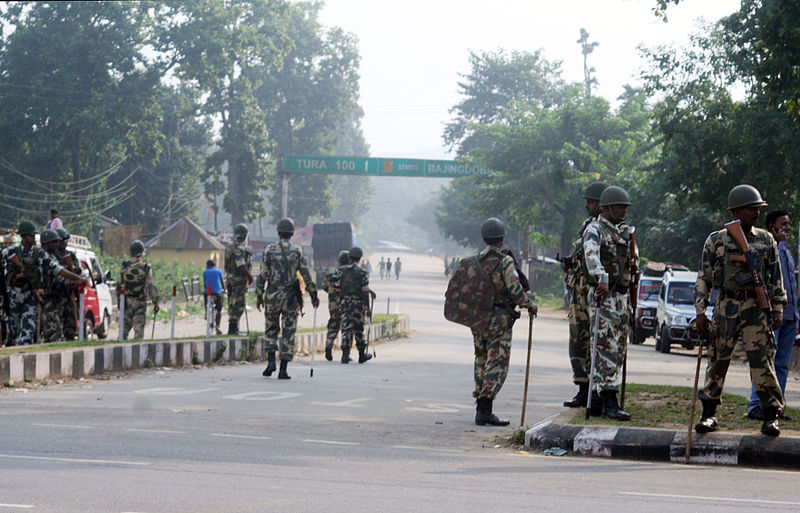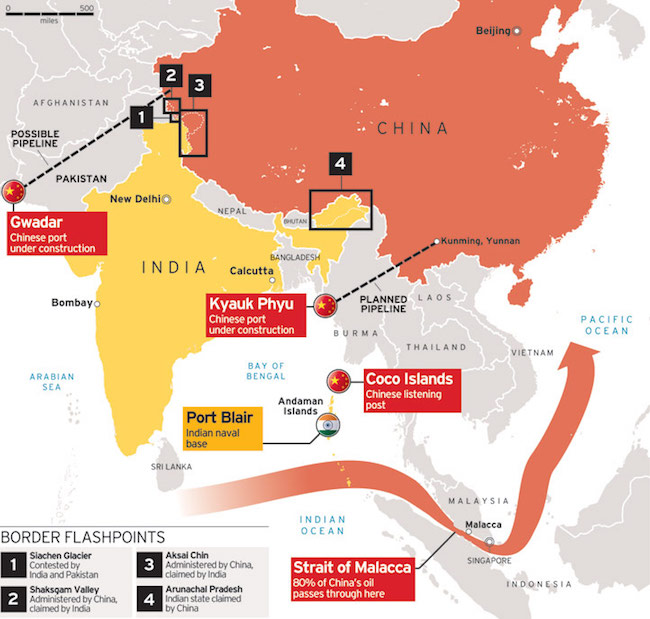India in Asia: Implications for the United States

By Zahid Khan
India’s mounting position in Asia and its alleged security impeaches mean that it share balancing interests with the United States. These interests can be summed up in three words: terrorism, energy, and China.[1] From 1962, when India lost its border war with China, until the mid-1980s, when India was to engage in a military show of strength along the Sino-Indian border, New Delhi had maintained a policy on non-antagonism vis-à-vis Beijing—at the same time, India also tolerated Chinese assistance to the Pakistani nuclear program. After the 1998 nuclear tests, however, India started to show a new confidence in its dealings with China, and the country’s strategic analysts began to discuss possible ways to contain China.[2]
India has followed a dual path in its relations with China. On the one hand, it has sought to normalize relations and, in 2003, the visit of Prime Minister Vajpayee brought about significant progress in this area. The two countries agreed to appoint special representatives to resolve the border dispute. More crucially, India stated that Tibet was a part of China, thus removing a long-standing irritant in the relationship. China reciprocated by tacitly accepting that the state of Sikkim was part of India. Second, trade between the two countries has flourished as China has replaced Japan as India’s largest trading partner in Asia—the two countries expect bilateral trade to cross $10 billion by the end of 2004. The burgeoning economic ties also have important consequences for the development of their respective domestic economies.[3]
For China, the economic development of its western regions lies in moving south through India and Burma. Lhasa to Kolkota was, until the Chinese takeover of Tibet, a long-standing trade route. For India its eastern and northeastern regions would benefit similarly from the opening of trade with China. The Northeast remains relatively underdeveloped, and Indian observers believe that greater trade with China would not only lead to greater prosperity, but also serve to lessen the support to existing insurgencies in the region. On the other hand, Indian military capabilities that have been growing incrementally provide India with the ability to contain Chinese expansion in Asia. Indian military doctrine has also started to shift from a South Asian focus to one that recognizes the need for a greater role in Asia. Indian Naval doctrine, for example, has been rewritten to give the Navy a blue water role and an operational sphere that stretches from the Straits of Hormuz to the Straits of Malacca.[4]
The Indian Navy is concerned about the growing Chinese presence in the Indian Ocean, particularly its using Myanmar as a location for monitoring facilities. Further, Indian defense analysts point out that the Chinese development of the Pakistani port of Gwadar helps the Chinese Navy encircle India—that has driven India’s plans to build up its long-range military capability. At the same time, India has been cautious about provoking China with its military buildup. It has committed itself to a reduction of forces along the Sino-Indian border, and in 1993 and 1996 signed confidence-building measures with China―the Peace and Tranquility Agreements―that reduced force levels and pulled backed forces along the border.[5]
India-China relations could go in three possible directions―coexistence, cooperation, and conflict. Coexistence would entail the trends of slow movement towards the resolution of the Sino-Indian border dispute. While there might be rhetorical exchanges, a backslide in the progress made in the resolution of the dispute is unlikely. A growth in trade with slower movement on the Indian side towards greater regional integration between the Chinese west and the Indian eastern and northeastern states—A slow move to build up the conventional and nuclear forces so that India would be in a position to deter China’s extra-regional power projection, should the political-military situation change.[6]
A cooperative relationship, on the other hand, would mean—Continuing progress that led to the relatively quick resolution of the border dispute. A move towards force reductions, especially reducing Chinese nuclear force levels. A concerted move by both countries towards regional economic integration, and attempts at joint research and development of civilian and possibly defense related technologies—China’s recognition of India’s role as a major Asian power and commensurate moves by Beijing to accommodate Indian interests. These would include dampening the Chinese relationship with Pakistan.[7]

A conflictual relationship could arise because of—the irretrievable collapse of the border talks and hostile Chinese movements in South East Asia. A significant Chinese boost to Pakistan’s nuclear and missile capabilities would also provoke a hostile reaction from India. A rapid move by India to militarize and upgrade its long range military capability—this would mean a move from creeping nuclearization to rapid nuclearization. If that happens, not only would the Chinese threat be reduced, but also true strategic stability would be established in Asia.[8]
Since the coexistence and conflict scenarios are more likely, it remains in American interests (as well as in those of the smaller Southeast Asian and East Asian nations) to see the emergence in Asia of a counterbalance to China—Economically, India is a large market with a bourgeoning middle class and technologically skilled labor force. This provides an alternative to China, although substantial reforms will be required before India becomes as attractive a market for foreign direct investments as China is. The other area where Indian military capability could be harnessed to facilitate American interests is in Central Asia. Indian interests there are driven by three factors: the need for energy resources and the potential of the Central Asian market; the attempt to counterbalance Chinese and Pakistani presence in the region; and the concern about radical Islam spreading from the region into India (especially Kashmir).[9]
India provided support to the Northern Alliance in Afghanistan and,—with the Taliban’s ouster, has sought to develop a presence in Central Asia. India has increased its cooperation with the Central Asian states, particularly Tajikistan, where it has reportedly established an air base. Such a base would only permit military action against anti-government forces in Central Asia. Like India, the Central Asian states are concerned about the growth of radical Islam and the threat it poses to their regimes that, because they are post-Soviet in orientation, tend to be secular.[10]
During Karzai government, India has covertly and actively engaged to establish a major diplomatic presence in Afghan cities and has reached an agreement to train the Afghan Army and intelligentsia (NDS) to destabilize and feeble the entire region of Pakistan particularly Baluchistan in order to get their national interest —Recently, Pakistan Army has snatched few of NDS spies and RAW agents involved in espionage activities in Baluchistan also available on record. [11]
For a United States impecunious for manpower, Indian security assistance especially would be welcome since it would further Washington’s own goal of checking terrorism in the region―thereby freeing U.S. troops for action in other theaters in the war against terror. In terms of energy and economics, India would like to play a growing role in Central Asia both to check the role of China and Pakistan but also to satisfy its own developmental needs. By 2010, Indian demand for natural gas may be as high as 77 billion cubic meters, and a steady supply of gas from the resource rich Central Asian countries would satisfy this demand. India, with Russia and Iran, is engaged, therefore, in the development of a NorthSouth corridor (one that passes from Mumbai to Tehran and from there to St. Petersburg) that would, among other things, open the Central Asian economies to the outside world.[12]
India’s stakes in Central Asia are, therefore, expanding, and we are seeing a series of complementary U.S. interests emerge. For both countries, checking the rise of radical Islam in the region is important. The opening of the Central Asian economies, in which India is participating, will reduce these countries’ crippling dependence on the other former Soviet states, particularly Russia. And if India is able to help bring Iran back into the international community of nations, it will create a safer energy corridor than the one currently proposed to run through Afghanistan and Pakistan.[13]
Growth in security cooperation between the United States and India would rest on the removal of constraints on Indian military and technological development, as well as an appreciation of India’s emerging power potential—this, however, is likely to be a long-term process and one marked with several speed bumps as the American war against terror and the global policies of nonproliferation work to limit what can be achieved in IndoU.S. relations.[14]
References
- A History of Indian Participation in UN Peacekeeping Operations, Embassy of India, Washington, DC, release, available at http://www.indianembassy.org/policy/Peace_ Keeping/history_india_UN_peace_keeping.htm.
- Ibid.
- Mira Sinha Bhattacharjea, A New Phase, Frontline, Vol. 20, Issue 14, July 5-18, 2003.
- C. Raja Mohan, India and China: A Shifting Paradigm, The Hindu, July 29, 2004, see also, Kalyan Chaudhuri, “Routes of Promise,” Frontline, Vol. 20, Issue 14, July 5-18, 2004.
- Rahul Bedi, A New Doctrine for the Navy, Frontline, Vol. 21, Issue 14, July 3-16, 2004.
- Ibid.
- The Seventh Flight of the Brahmos, Frontline, Vol. 21, Issue 13, June 19-July 2, 2004.
- Tellis, India’s Emerging Nuclear Posture: Between Recessed Deterrence and Ready Arsenal, p. 474.
- Stephen Blank, India’s Rising Profile in Central Asia, Comparative Strategy, Vol. 22, No. 2, 2003, p. 140; Shahram Akbarzadeh, India and Pakistan’s Geostrategic Rivalry in Central Asia, Contemporary South Asia, Vol. 12, No. 2, June 2003, p. 220.
- Rahul Bedi, India and Central Asia, Frontline, Vol. 19, Issue 19, September 14-27, 2002.
- Rahul Bedi, Strategic realignments, Frontline, Vol. 20, Issue 13, June 21-July 4, 2003.
- Akbarzadeh, p. 222.
- Sudha Ramachandran, India, Iran, Russia Map Out Trade Route, Asia Times, June 29, 2002.
- Foreign Students Diminishing in Indian Universities, The Hindustan Times, February 9, 2004.




